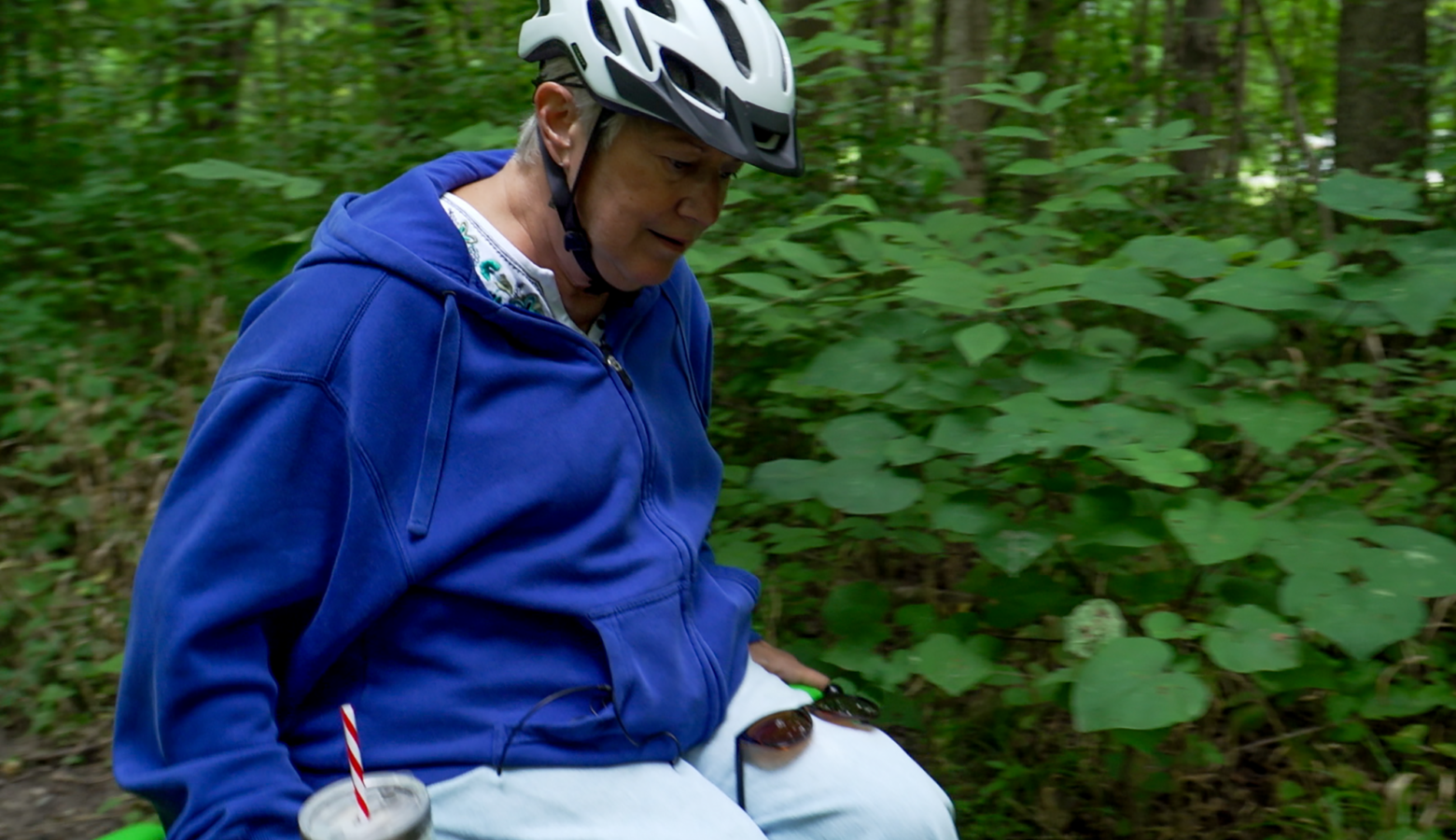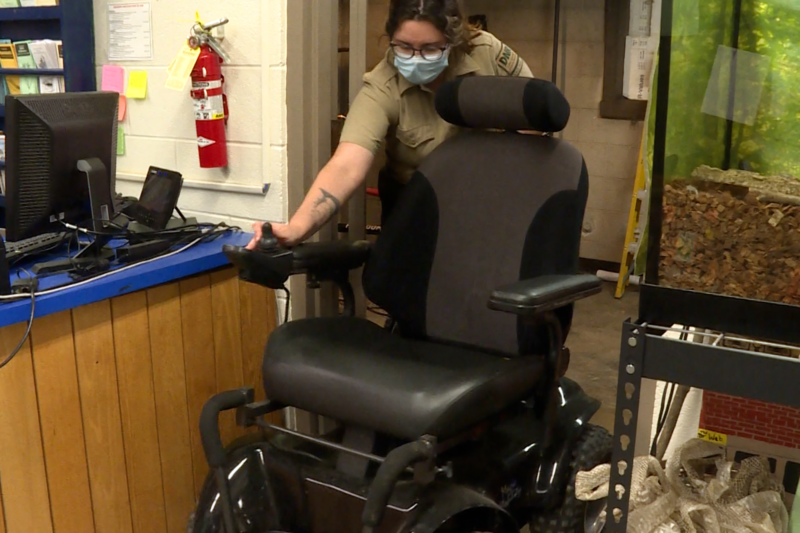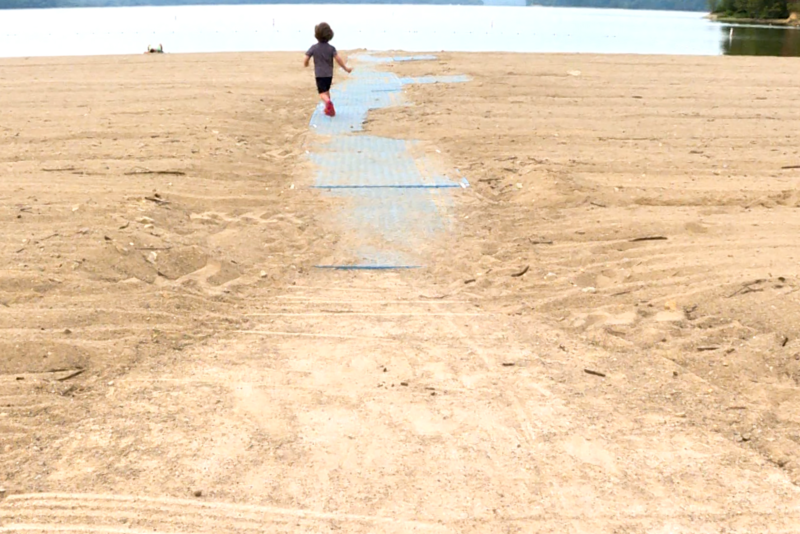Indiana aims to make the outdoors more accessible for people with disabilities

Indianapolis resident Nancy Griffin maneuvers over tree roots on a trail in Eagle Creek Park — using a motorized wheelchair affectionately known as Peggy.
“Short for Pegasus, because she flies,” Griffin said.
With Peggy’s help, Griffin can get to places and overcome obstacles she might not have been able to before. She said she enjoys the challenges that come up on the trail.
“It makes it more fun,” Griffin said. “I haven’t been able to walk for over a dozen years, so being able to get out and walk through the woods is just the most wonderful gift.”
The state of Indiana is trying to make it easier for people with disabilities to enjoy the outdoors. Experts say things like accessible parks and trails benefit many more people than just those who have disabilities — and that includes the state itself.
Though Griffin has her own chair for trails, the Indiana Department of Natural Resources loans out motorized chairs at 11 state parks. This year, the agency launched a webpage where people with disabilities can find things like trail chairs as well as accessible places to hike, fish, hunt or get in the water.
Ric Edwards is the director of Americans with Disabilities Act compliance for the DNR. He said at first, he didn’t want to have an accessibility webpage — he didn’t want people with disabilities to feel limited to only going to certain trails and parks.
“Then I realized that we had not done — I had not done a good job of promoting a lot of the things that are out there that we’ve been working on for years. For example, we’ve had trail chairs since 2006,” Edwards said.

An employee at McCormick’s Creek State Park shows how caregivers often bring their trail chairs to visitors with disabilities. (Rebecca Thiele/IPB News)
The number of adults in the U.S. that have some type of disability has been slowly increasing over time. Edwards said people with disabilities are living longer and they want to be able to enjoy nature the way everyone else does.
“People with disabilities are coming back from Iraq and Iran, military situations where, you know, they want to go out and experience the same things they experienced before,” he said.
Edwards said getting rid of barriers for people with disabilities benefits other folks too — particularly children. Having lower railings in wildlife viewing areas can ensure someone sitting or a child standing can both see the sandhill cranes. Ramps accommodate wheelchairs and strollers.
A beach mat at Paynetown State Recreation Area in Bloomington makes it so wheelchairs can roll down to the lake — or kids can keep their feet cool and off the hot sand.

Beach mats make it so wheelchair users can get to the water at Lake Monroe more easily, but they can also keep kids’ feet off the hot sand. Ric Edwards of the Indiana DNR said many accessible upgrades are helpful for other people too. (Rebecca Thiele/IPB News)
Edwards said better access is, first-and-foremost, the right thing to do. But it’s also financially smart.
“We’re trying to reach out to all people. And if we purposefully exclude a group of people, we’re not only excluding them but we’re excluding their families and their friends and everybody else. So, I would say that’s certainly on our minds that this is income generating, but it’s not the priority,” he said.
Though the DNR has done a lot to make its properties physically accessible, Edwards said there’s still more to do. He said he’d like to see more tactile exhibits like the one at Falls of the Ohio State Park, which allows someone who’s blind or has limited vision to feel models of the fossils under the water.
Nancy Griffin said she’d like to see more braille and more accommodations for people who are sensitive to bright lights or loud noises.
“I’d love to see a trail walk or a bird hike here at the park with someone who’s an interpreter giving the talk, so that people who are deaf can go. You don’t have to hear the birds. If you can see them, you can still enjoy them,” she said.
Edwards said feedback from the public is the main way the DNR prioritizes properties for accessible upgrades.
Even hearing from one person can sometimes turn into action. Edwards said the DNR once made a brand new ramp at a park shelter so that a person in a wheelchair could attend their family reunion.
The DNR has put out a survey to find out which natural spaces in Indiana need more accessibility.
Rebecca is our energy and environment reporter. Contact her at [email protected] or follow her on Twitter at @beckythiele.

